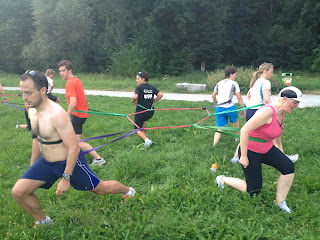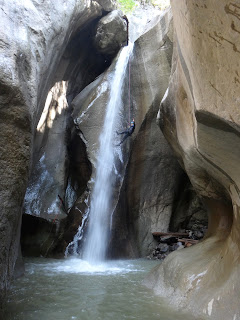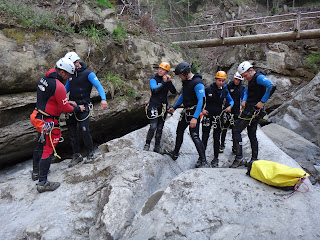Three weeks we have had to do without the ever popular Wednesday night running sessions led by Coach Jeff. Two sessions took place with a stand-in coach, although I was unable to attend those due to other commitments, and the other Wednesday was a public holiday (Swiss National day - 1st August), so no session took place. We were all happy to see him back!
For a welcome present he got us to do pinwheeel. If you don't know what pinwheel is, it is a very hard intervals session. The pinwheel session this time lasted for 20 minutes. Pinwheel consists of a centre and then 4 spokes that lead out from the centre. You either run hard out to the end of the spoke and then easy back, or vice versa depending on what coach Jeff says. The whole group is split into similar paced runners, and each of those smaller groups is assigned a spoke. After completing your assigned spoke each group rotates either clockwise or anticlockwise to the next spoke, depending on what coach Jeff says.
I was in the group with Femi and Tobias, both extremely fit runners. Femi is training for the Ultra-Trail du Mont Blanc® and Tobias is training for the Jungfrau Marathon. Tobias and myself being extremely competitive, we gave it our all from the moment go. At first I was out sprinting Tobias and he was very surprised, since he usually beats me. My lack of speed endurance soon showed up though, and I started dropping back. I have the speed but not the speed endurance it seems. Speed endurance is the ability to cover distance at speed, and not just how fast you can sprint (which is speed), or how long you can run (which is endurance). This is what I will focus on in my training over the coming weeks, but is no surprise that I have a lack of speed endurance at present, having only run just over 70km in the last month. Speed endurance is critical when attempting a sub 3 hour marathon however.
After completing the pinwheel exercise we rounded the session off with some group resistance training exercises. You can see examples of these in the photos above and below. We were all attached together by means of resistance bands, and then as a group we had to complete sets of both lunges and squats. The resistance bands ensure that the hamstrings also get a good workout, and not just the quadriceps.
Next week is the final lesson of the current series, so we will be repeating the benchmark run that we performed in the first lesson of the series. It will be interesting to see if I have improved or if my performance has dropped yet again. I predict that my time will be similar to last time, as although I have not trained much over the last month, my energy levels have come back up to normal again.
With this weekend set to be a scorcher in terms of temperature (well in Switzerland at least) I wish you all a hot, sunny weekend.
The training diaries of a formerly overweight, office worker who decided to turn himself into a hardcore endurance athlete and take on the toughest footrace in the world, the Marathon des Sables in Morocco. With this completed in April 2012, his fitness journey continues, most recently with a 26.4km marathon lake swim
Friday, 17 August 2012
Tuesday, 14 August 2012
Canyoning in Chli Schliere - an amazing experience, but strong nerves and complete trust in the guide required
Scared of heights, nervous disposition? If so then canyoning is probably not the best activity for you to try. Especially not canyoning in Chli Schliere, one of the most extreme canyons in Central Switzerland.
That being said, if you are of an adventurous nature and don't suffer from serious vertigo (I am not brilliant with heights, yet managed Chli Schliere just fine), canyoning is one of the most fun outdoor activities that I have ever tried (up there alongside paragliding and ice climbing).
Dictionary.com defines canyoning as "the sport of travelling down a river situated in a canyon by a variety of means including scrambling, floating, swimming and abseiling". Based on my experience last Saturday in Chli Schliere, this is a fitting definition.
I organised my canyoning trip with Exclusive Adventure, a Zurich based company owned by a friendly Swiss guy called Roman. There were 8 of us in total on the trip, myself, 2 couples, the assistant guide and his partner and Roman (the guide). I was the only English speaking person in the group, but Roman speaks English very well and gave the instructions in both Swiss German and English.
We met at a cafe opposite the Pilatusbahn in Alpnachstad at 8am, and then after a quick coffee drove over to near the entry point to the canyon. After putting on a neoprene wetsuit, helmet and harness we made the short walk through the forest to the start point. As we entered the canyon Roman warned us that we needed to listen carefully to his instructions at all times, especially when doing the jumps, as there are certain spots where you must not land when jumping, due to rocks and other obstacles just below the water's surface. The water in Chli Schliere is rather murky and this is why you require complete trust in the guide. You only have his word for it that the place where you are jumping is safe, and that there are no submerged rocks there.
It was only after a few minutes of wading through knee deep water that we were presented with our first possible jump. It was only around 6m in height, but there were rocks directly below where the water was falling and for those wishing to attempt it as a jump they needed to launch themselves towards the side wall of the canyon to ensure enough clearance when landing. The launch point was also sloped and the feet had to be placed in the water, so it was not the easiest jump in the world. The great thing about canyoning in Chli Schliere is that there are fixed ropes everywhere and you always have the option of abseiling down rather than jumping. Some of the group chose to abseil down and others like myself chose to make the jump. The assistant guide helped us by allowing us to tread on his foot in order to get a secure footing on the sloped surface and avoid the risk of slipping during takeoff.
All safely down the first jump by whatever means we had chosen, shortly afterwards came our first true abseiling section. Jumping this time was not allowed due to numerous obstacles in the pool below. The technique for abseiling is rather simple and can be picked up within several minutes. The most important aspect that most first timers struggle with is leaning out so that they are perpendicular to the rock that they are abseiling down. If you are scared of heights then you tend to stay too upright and this actually means you are more likely to slip and scare yourself further.
Then came our first slide. Slides are sections that are less than vertical and where the water has carved a passage that allows you to pass down it without the risk of hitting obstacles. There is one example of a slide in the photograph at the top of the page. This was a longer slide that we attempted towards the end of the trip. The technique when moving down a slide is to hold your hands directly above your head (or in certain cases above your head and in front of your face to protect it) so as not to risk injuring your arms. The slides require less skill than the jumps and are more suitable for every member of the group.
The largest jump we made during the trip was around 10m in height. It may not sound that much at first, but when you think of it in terms of buildings, it is higher than a 3 storey building. It doesn't seem high looking up once the jump has been completed, but looking down it is another story.
There was also one jump where you had to throw yourself directly into the canyon wall and then slide down it, in order to arrive at the required landing spot in the pool below. Throwing yourself at a wall seems very counter intuitive I can tell you, but we managed it somehow.
The longest slide in the trip was around 25m. I cannot describe how much fun that was, and even better, everyone attempted it. In total we spent between 3 and 4 hours in the canyon and everyone seemed to be throughly enjoying themselves. One girl in the group was really at her limit and was struggling to do some of the slides and jumps, but once down and with the applause of everyone else in the group she looked really pleased with herself.
I cannot claim that canyoning is the safest sport on the planet by any means, but most accidents occur when scrambling over the rocks rather than on the jumps or slides. If you listen carefully to the guide's instructions and are good at crossing rough terrain, it may well be worth a try. It is an activity you will most likely remember with a smile on your face for some time afterwards. Each canyon has its own hydrology and some are more likely to be at risk of flash flooding. The risk of hitting submerged obstacles can be reduced by going to canyons where the water is clear. This allows you to see the submerged obstacles from above. The water level is also an important factor in deciding whether it is safe to jump or not. This is why it is critical to go with a reputable company and a well informed guide. Having seen how Roman approached the trip, I can certainly recommend him. The trip was cancelled several times beforehand due to bad weather, which is a sign that he is responsible in his attitude to the sport.
Top marks all round, and that is one trip I won't be forgetting for a long time to come!
Subscribe to:
Posts (Atom)





